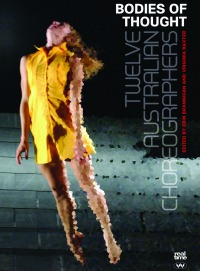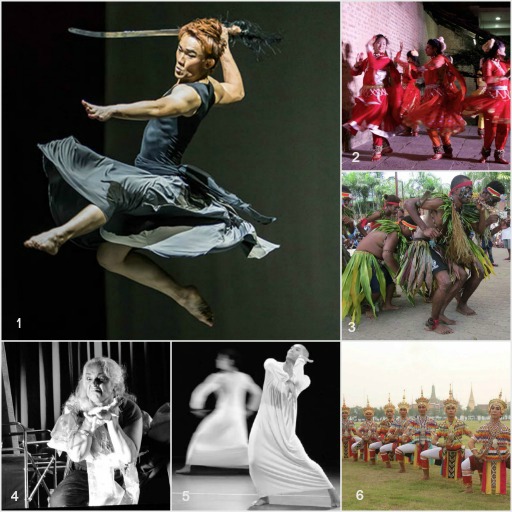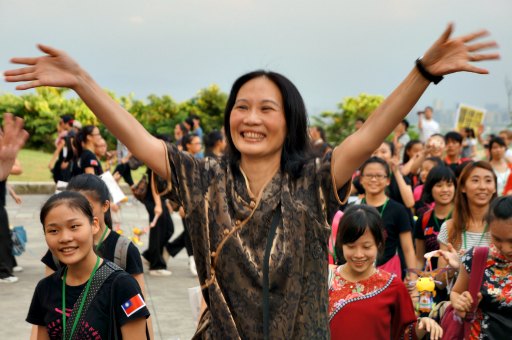Creating dance
News / Blog / Press Releases / Events
New Artistic Director for Force Majeure
Jo Dyer, Chair of the Board of Force Majeure has announced the appointment of Danielle Micich as the incoming Artistic Director/CEO for the company, replacing founding Director Kate Champion. Jo said:
The Board of Directors is delighted that Danielle has accepted the role of Artistic Director of Force Majeure. Danielle’s body of work demonstrates an immensely talented and rigorous artist who has thought passionately and deeply about dance theatre and the role it occupies in the Australian and international arts landscape. We can think of no-one better to build on the wonderful legacy being left by Kate Champion. We believe that under Danielle’s leadership, Force Majeure will continue to flourish in the unique space Kate has carved out for us, a genuine cross-artform blend of theatre and dance, dedicated to exploring ideas and ourselves.
Bodies of Thought: 12 Australian Choreographers
This book on Australian contemporary dance focuses specifically on innovative choreographers, concentrating on a work by each with an accessible interview and an insightful essay by a leading dance writer. It is ideal for dance practitioners, students and researchers as well as seasoned dance audiences.
Beautifully designed and affordably priced, the book includes superb images of the dance works taken by Australia's best dance photographers.
 Bodies of Thought: 12 Australian Choreographers features a generation of award-winning Australian choreographers with international reputations and legacies of influence: Kate Champion, Rosallnd Crisp, Tess De Quincey, Russell Dumas, Lucy Guerin, Sue Healey, Helen Herbertson, Gideon Obarzanek, Stephen Page, Garry Stewart, Meryl Tankard and Ros Warby.
Bodies of Thought: 12 Australian Choreographers features a generation of award-winning Australian choreographers with international reputations and legacies of influence: Kate Champion, Rosallnd Crisp, Tess De Quincey, Russell Dumas, Lucy Guerin, Sue Healey, Helen Herbertson, Gideon Obarzanek, Stephen Page, Garry Stewart, Meryl Tankard and Ros Warby.The field of innovative dance in Australia is vibrant and diverse. With their extensive background as writers in the field, the aditors have created a collection of essays that offers a lucid account of a wide range of experimental dance work and conveys some of the excitement it generates in live performance.
—Jane Goodall, Adunct Professor, The University of Western Sydney.
Editors: Erin Brannigan, Senior Lecturer in Dance, School of Arts and Media, UNSW and Virginia Baxter, Managing Editor, RealTime.
Publishers: RealTime and Wakefield Press. RRP: $34.95
The RealTimeDance archive [1994-present] features a range of interviews, articles, reviews, video excerpts and links about the body of work of each of the twelve choreographers featured in this book, as well as providing information about those works and others which are available online or as DVDs or for loan. Visit the Dance Archive on the RealTime website to find out more.
Keir Choreographic Award—winner announced
The inaugural Keir Choreographic Award has been awarded to Atlanta Eke. The People's Choice Award went to Sydney artist Jane McKernan, as selected by audience members at the grand final at Carriageworks.
Four of the eight commissioned artists—Sarah Aiken, Matthew Day, Atlanta Eke, Jane McKernan—competed for the inaugural award at Carriageworks in Sydney in July.
Dancehouse residency programs
The Housemate programs reflect Dancehouse's commitment to advancing innovative contemporary dance in Australia by instigating and nurturing rigorous discourse and encouraging wide-ranging, movement-based experimentation and innovative choreographic practices.
Both Performance and Research Housemate programs provide the artist with extensive time, generous financial support and a thoroughly mentored environment. The Housemate program is one of the very few fully paid artist-in-residence programs in the world. Artists are given between 8 and 14 weeks of free studio space, a salary package (or pro rata), and administrative, mentoring and production support. Housemates are selected by a peer advisory panel from a national call for applicants.
2014 International Dance Day message
On 29 April every year, the international dance community celebrates International Dance Day.
We celebrate our art form's ability to cross all political, cultural and ethnic barriers and bring people together with a common language—dance.
Journal of Emerging Dance Scholarship
The Journal of Emerging Dance Scholarship (JEDS) is published annually in September by the World Dance Alliance (WDA). It is designed to serve the needs of international dance scholars who are currently enrolled in a graduate program or within 5 years of having graduated from a graduate program in dance or a related field.
JEDS is published online as an open resource. Articles are selected to assure dance scholarship from around the world is included in each publication.Each article submission is reviewed by two international dance scholars with no more than 16 submissions accepted for the annual publication. Articles are chosen based on originality of research and the contributions each makes to the future of dance praxis (theory and practice).
JEDS Vol. 2 will be published 1 September, 2014
JEDS 2015 Vol. 3, will be comprised only of blind-reviewed papers selected from those presented at the 2014 World Dance Alliance Global Summit in Angers, France.
Visit the JEDS website to find out more.
Accessible Arts masterclasses 2013
Join leading choreographers, Sue Healey, Dean Walsh and Philip Channells in the Catalyst Dance Masterclass Series.
Accessible Arts is hosting a series of three masterclasses tailored to dancers with and without physical or sensory disability, and people with mental illness or acquired brain injury.
New Asia–Pacific Channels edition
The latest edition of Channels is jam-packed with exciting new dance activity in Asia and the Pacific. There are new dance networks, events, research, journals, books and more.
Some of the highlights include a new Nepal chapter of World Dance Alliance; plans for the 2014 Global Dance Summit, which will be held at the beautiful Centre National de la Dance Contemporaine in Angers, France; and Our Roots Right Now—The Research Forum and Festival of Thai/ASEAN Contemporary Theatre, at Chulalongkorn University, Bangkok, Thailand.
 1] Ter Wei Lun from Lee Wushu Arts Theatre in Wushu Madness II–The Realm Between, choreographed by Lee Swee Seng, in the Showpiece Performances of MyDance Festival 2013, at Panggung Bandaraya on 31 May 2013. Photo: Huneid Tyeb. 2] Kathak dance performed by Kalanidhi Indira Sangeet Mahabidhayalaya at International Dance Day on 29 April 2013 at Yalam Maya Kendra in Kathmandu, organised by the newly inaugurated WDAAP Nepal chapter. Photo by Raju Shakya & Prabin Lal Singh. 3] A ceremonial dance from the West New Britain province of Papua New Guinea, performed during the Foundation Day Celebrations at Port Moresby Grammar School on 4 April 2013. Photo: Naomi Faik-Simmer 4] Dr Maya Krishna Rao in her performance Ravanama, during the seminar ‘The Moving Space: Women in Performance’ at the Rabindranath Tagore Centre, Kolkata, on 3 February 2013. Photo: Kolkata Sanved 5] Thai choreographer Pichet Klunchun in his section of the tripartite Fire Fire Fire, on 28 January 2013 in the ‘Our Roots Right Now’ research forum and festival at Sodsai Pantoomkomol Centre for Dramatic Arts. Photo: L. Skar 6] The Nora Thummanit Thaksin University Group who performed Nora: Klong Hong in January 2013 in the ‘Our Roots Right Now’ research forum and festival at Sodsai Pantoomkomol Centre for Dramatic Arts.
1] Ter Wei Lun from Lee Wushu Arts Theatre in Wushu Madness II–The Realm Between, choreographed by Lee Swee Seng, in the Showpiece Performances of MyDance Festival 2013, at Panggung Bandaraya on 31 May 2013. Photo: Huneid Tyeb. 2] Kathak dance performed by Kalanidhi Indira Sangeet Mahabidhayalaya at International Dance Day on 29 April 2013 at Yalam Maya Kendra in Kathmandu, organised by the newly inaugurated WDAAP Nepal chapter. Photo by Raju Shakya & Prabin Lal Singh. 3] A ceremonial dance from the West New Britain province of Papua New Guinea, performed during the Foundation Day Celebrations at Port Moresby Grammar School on 4 April 2013. Photo: Naomi Faik-Simmer 4] Dr Maya Krishna Rao in her performance Ravanama, during the seminar ‘The Moving Space: Women in Performance’ at the Rabindranath Tagore Centre, Kolkata, on 3 February 2013. Photo: Kolkata Sanved 5] Thai choreographer Pichet Klunchun in his section of the tripartite Fire Fire Fire, on 28 January 2013 in the ‘Our Roots Right Now’ research forum and festival at Sodsai Pantoomkomol Centre for Dramatic Arts. Photo: L. Skar 6] The Nora Thummanit Thaksin University Group who performed Nora: Klong Hong in January 2013 in the ‘Our Roots Right Now’ research forum and festival at Sodsai Pantoomkomol Centre for Dramatic Arts.NAAE welcomes new Arts Curriculum
The National Advocates for Arts Education (NAAE) has warmly welcomed news the ACARA Board has approved the new The Australian Curriculum: The Arts. NAAE, of which Ausdance is a member, has strongly supported the development of the arts curriculum and its central principle of the entitlement of every young Australian to an arts education, one that includes all five artforms – dance, drama, media arts, music and the visual arts.
National Dance Forum program
Opening and closing with interactive visioning sessions, the program featured a full morning 'Open Space' session on the Sunday tapping the pulse of the forum, and through it that of the dance sector in Australia.
Keynote artists-in-conversation were Dalisa Pigram, co-Artistic Director of Marrugeku, with David Pledger, and Artistic Director of Australian Dance Theatre Garry Stewart with Anne Thompson.
National dance forum—latest news
The National Dance Forum 2013 is set to continue the national conversation begun at the inaugural event in 2011. Providing a space for sector debate, discussion and ideas, the forum will focus on the central question, "Why dance?"
“It's a question we all ask ourselves as makers and performers, but the answers are often complex, leading our thinking in multiple directions—why do we, as artists, use dance as our chosen form? What has led us into this lifetime of practice? Why do humans seem to have such an inate and intrinsic connection with dance?” says Brian Lucas, National President of Ausdance.
“The National Dance Forum offers participants a wonderful opportunity to foster the artistic development of Australian dance through inspiration, reflection and critical dialogue,” says Elizabeth Walsh, the recently appointed chair of the Australia Council Dance Board.
Presented by project partners Australia Council for the Arts and Ausdance National, the second National Dance Forum (NDF2013) will take place at Footscray Community Arts Centre in Melbourne, 15 – 17 March 2013 and will coincide with the contemporary dance festival, Dance Massive
Read the full Media Release
Dance, young people & change—diversity in action
The collaboration between World Dance Alliance (WDA) and dance and the Child international (daCi) produced one of the biggest global dance festivals ever held—Dance, Young People and Change. Hosted by the Taiwan National University of the Arts (TNUA) in Taipei, the event attracted young people from North and South America, Europe, the UK and most Asia-Pacific nations.
The festival/conference was a multi-layered event that included keynote addresses, ‘dance flavour’ taster classes, workshops, forums and paper presentations. It brought together young people, their parents, mentors and educators from across the world to reflect on key issues and future directions for dance in young people’s lives.
 Ann Tai, Taiwan representative for daCI and teacher at TNUA, exuberant in the opening parade.
Ann Tai, Taiwan representative for daCI and teacher at TNUA, exuberant in the opening parade.There was also a wonderful range of performances by young people, a festival of international dance academies, and an amazing program of Taiwanese dance performed by Taiwan’s professional companies and groups, including Cloud Gate 2 and Dance Forum. Teachers attended masterclasses and paper presentations and exchanged ideas about approaches to dance learning, teaching and curriculum for young people.
BlakDance 2012 triumph
BlakDance 2012 festival in Brisbane highlighted a wonderful range of contemporary Indigenous dance from Australia and New Zealand.
Choreographers, dancers, industry members and audiences came together to celebrate and gain a deeper understanding of contemporary Indigenous dance practice.
‘Shades of us’—a stunning AYDF finale
It was fantastic to be able to join the Ausdance NSW team, the choreographers and more than 150 young people from all over Australia on the last day of the Australian Youth Dance Festival at NAISDA Dance College in Gosford NSW.
Shades of Us, presented in Mt Penang Gardens on the final evening, was a performance that grew out of an intensive week of creative development with choreographers Sue Healey, Philip Channells, Anton, Kay Armstrong, Matt Cornel, Adelina Larsson, Lee Pemberton, Vicki Van Hout and artistic director Rowan Marchingo.
Communities making dance in Tasmania
Tasmanian Regional Arts (TRA) is leading The Dance Project in partnership with Mature Artists Dance Experience (MADE), Bust a Move and Tasdance.
This community dance project is happening in three Tasmanian regions—the North East, North West and the South—to develop and present three new contemporary dance works with, by and about communities. Evolving from the heart of each community, these works explore place, kinship and identity as experienced by the residents of these regions.
Building the Indigenous contemporary dance collection
Ever since we convened the 2005 Creating Pathways national Indigenous dance forum in Canberra, Lee Christofis—one of the keynote speakers, and now curator of dance at the National Library of Australia—has been keen to develop the NLA's Indigenous dance collection.
In the March 2012 edition of National Library News, Lee discusses some of the material now held in the collection and outlines the importance of its provenance.
Building the Indigenous contemporary dance collection makes fascinating reading for anyone interested in the development of Australian contemporary Indigenous dance.
More evidence that dance benefits the elderly
There are some startling new figures that support dancing as a protective strategy in preventing dementia. A Stanford University report Use It or Lose It: Dancing Makes You Smarter makes the following comparisons:
... almost none of the physical activities appeared to offer any protection against dementia. There can be cardiovascular benefits of course, but the focus of this study was the mind. There was one important exception: the only physical activity to offer protection against dementia was frequent dancing.
- Reading—35% reduced risk of dementia
- Bicycling and swimming—0%
- Doing crossword puzzles at least four days a week—47%
- Playing golf—0%
- Dancing frequently—76%.
The same university offers other insights into the benefits of dance in Thoughts, philosophies and musings on social dance, a useful reference for community dance practitioners in Australia.
New research with dance and the elderly
New research by the University of Western Sydney is demonstrating that folk dance has clear benefits for the health of the elderly. You may have missed this great report from the ABC’s 7.30 program on 4 January.
Youth dance—where does it fit?
In responding to our suggestion of a campaign to support the smaller key dance organisations, Ruth Osborne, artistic director of QL2 Dance, came in to discuss some of the issues youth dance companies are experiencing.
Restless Dance Theatre’s Junction project
Junction is an artist exchange program initiated by Restless Dance Theatre to support and promote the development of new independent work. Piloting this program is independent artist Tobiah Booth-Remmers who is being mentored by Carol Wellman Kelly through the national JUMP mentoring program.

